
- Subject:
- History
- U.S. History
- Material Type:
- Unit of Study
- Provider:
- Ohio Open Ed Collaborative


In the nation’s first few years, no organized political parties existed. This began to change as U.S. citizens argued bitterly about the proper size and scope of the new national government. As a result, the 1790s witnessed the rise of opposing political parties: the Federalists and the Democratic-Republicans. Federalists saw unchecked democracy as a dire threat to the republic, and they pointed to the excesses of the French Revolution as proof of what awaited. Democratic-Republicans opposed the Federalists’ notion that only the wellborn and well educated were able to oversee the republic; they saw it as a pathway to oppression by an aristocracy.

The eighteenth century witnessed the birth of Great Britain (after the union of England and Scotland in 1707) and the expansion of the British Empire. By the mid-1700s, Great Britain had developed into a commercial and military powerhouse; its economic sway ranged from India, where the British East India Company had gained control over both trade and territory, to the West African coast, where British slave traders predominated, and to the British West Indies, whose lucrative sugar plantations, especially in Barbados and Jamaica, provided windfall profits for British planters. Meanwhile, the population rose dramatically in Britain’s North American colonies. In the early 1700s the population in the colonies had reached 250,000. By 1750, however, over a million British migrants and African slaves had established a near-continuous zone of settlement on the Atlantic coast from Maine to Georgia. During this period, the ties between Great Britain and the American colonies only grew stronger. Anglo-American colonists considered themselves part of the British Empire in all ways: politically, militarily, religiously (as Protestants), intellectually, and racially.
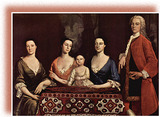
The eighteenth century witnessed the birth of Great Britain (after the union of England and Scotland in 1707) and the expansion of the British Empire. By the mid-1700s, Great Britain had developed into a commercial and military powerhouse; its economic sway ranged from India, where the British East India Company had gained control over both trade and territory, to the West African coast, where British slave traders predominated, and to the British West Indies, whose lucrative sugar plantations, especially in Barbados and Jamaica, provided windfall profits for British planters. Meanwhile, the population rose dramatically in Britain’s North American colonies. In the early 1700s the population in the colonies had reached 250,000. By 1750, however, over a million British migrants and African slaves had established a near-continuous zone of settlement on the Atlantic coast from Maine to Georgia. During this period, the ties between Great Britain and the American colonies only grew stronger. Anglo-American colonists considered themselves part of the British Empire in all ways: politically, militarily, religiously (as Protestants), intellectually, and racially.

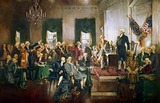
While the Articles of Confederation formed a loose working political body for the colonists to wage war, its shortcomings quickly became evident. The deliberations over the new form of government, worthy of the sacrifices and meeting the lofty ideals of the Revolutionaries became another struggle to define the meaning of the Revolution.

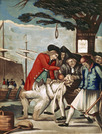
The government’s formerly lax oversight of the colonies ended as the architects of the British Empire put these new reforms in place. The British hoped to gain greater control over colonial trade and frontier settlement as well as to reduce the administrative cost of the colonies and the enormous debt left by the French and Indian War. Each step the British took, however, generated a backlash. Over time, imperial reforms pushed many colonists toward separation from the British Empire.

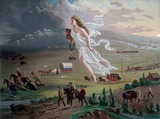
"Although called into name in 1845, manifest destiny was a widely held but vaguely defined belief that dated back to the founding of the nation. First, many Americans believed that the strength of American values and institutions justified moral claims to hemispheric leadership. Second, the lands on the North American continent west of the Mississippi River (and later into the Caribbean) were destined for American-led political and agricultural improvement. Third, God and the Constitution ordained an irrepressible destiny to accomplish redemption and democratization throughout the world. All three of these claims pushed many Americans, whether they uttered the words manifest destiny or not, to actively seek the expansion of democracy. These beliefs and the resulting actions were often disastrous to anyone in the way of American expansion. The new religion of American democracy spread on the feet and in the wagons of those who moved west, imbued with the hope that their success would be the nation’s success." - American Yawp, Chap 12 Introduction[Image - John Gast, American Progress, 1872. Wikimedia.]

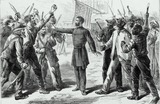
“After the Civil War, much of the South lay in ruins… The future of the South was uncertain. How would these states be brought back into the Union? Would they be conquered territories or equal states? How would they rebuild their governments, economies, and social systems? What rights did freedom confer on formerly enslaved people? The answers to many of Reconstruction’s questions hinged on the concepts of citizenship and equality. The era witnessed perhaps the most open and widespread discussions of citizenship since the nation’s founding. It was a moment of revolutionary possibility and violent backlash… Resistance continued, and Reconstruction eventually collapsed. In the South, limits on human freedom endured and would stand for nearly a century more.”-The American Yawp, Chap. 15 Introduction[Image: The Freedmen’s Bureau; Alfred Rudolph Waud; Published in Harper’s Weekly on July 25, 1868; The Historic New Orleans Collection ]

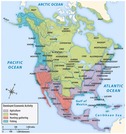
What Europeans called “the New World” had people living there that had been there for thousands of years. Great civilizations had risen, large population centers had come and gone, and the people we know today as Native Americans or First Americans spoke many languages, had trade routes, treaties, and a variety of religions. Africa, or more specifically, West Africa, also had great kingdoms, trade routes, and a large variety of languages, religions, and traditions. Many West Africans had already encountered European and Middle Eastern peoples through trade along the sea ports and across the Mediterranean. As religious and social turmoil changed the European landscape, new inventions like the caravel, astrolabe and compass allowed for easier and safer sea travel. Spain and Portugal led the search for an easier route to the Far East and discovered the New World. They were quickly followed by the French and British. Soon the Columbian Exchange would bring changes to the New World that no one could have expected, or predicted.

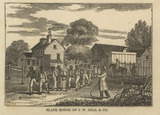
"Nine new slave states entered the Union between 1789 and 1860, rapidly expanding and transforming the South into a region of economic growth built on slave labor... By the mid-nineteenth century, southern commercial centers like New Orleans had become home to the greatest concentration of wealth in the United States. While most white southerners did not own slaves, they aspired to join the ranks of elite slaveholders, who played a key role in the politics of both the South and the nation. Meanwhile, slavery shaped the culture and society of the South, which rested on a racial ideology of white supremacy and a vision of the United States as a white man’s republic. Slaves endured the traumas of slavery by creating their own culture and using the Christian message of redemption to find hope for a world of freedom without violence." - OpenStax U.S. History, Chap. 12 Intro[Image - a panel of "Slave Market of America", A broadside published by the American Anti-Slavery Society in 1836 - Library of Congress Prints & Photographs Division ]

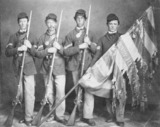
"The American Civil War, the bloodiest in the nation’s history, resulted in approximately 750,000 deaths. The war touched the life of nearly every American as military mobilization reached levels never seen before or since... The Civil War was a defining event in the history of the United States and, for the Americans thrust into it, a wrenching one." -The American Yawp, Chap. 14 Introduction[Image: 23rd Ohio Volunteer Infantry Color Guard - Ohio History Connection]

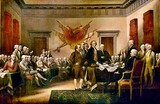
By the 1770s, Great Britain ruled a vast empire, with its American colonies producing useful raw materials and profitably consuming British goods. From Britain’s perspective, it was inconceivable that the colonies would wage a successful war for independence; in 1776, they appeared weak and disorganized, no match for the Empire. Yet, although the Revolutionary War did indeed drag on for eight years, in 1783, the thirteen colonies, now the United States, ultimately prevailed against the British. The Revolution succeeded because colonists from diverse economic and social backgrounds united in their opposition to Great Britain. Although thousands of colonists remained loyal to the crown and many others preferred to remain neutral, a sense of community against a common enemy prevailed among Patriots.